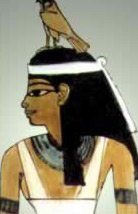Amentet, Goddess of the Dead, Personification of the West
by Caroline Seawright



Amentet (Ament, Amentit, Imentet, Imentit) was the Egyptian goddess and friend of the dead, and the personification of the Land of the West, 'Amenti'. It was she who welcomed the deceased to their new dwelling place in the netherworld. She was also a goddess who helped with the rebirthing process, and thus a goddess of fertility and rebirth, who regenerated the deceased with food and water.
She was depicted as a beautiful woman as wearing the hieroglyph of the west -  - on her head, carrying a scepter and the ankh of life in her hands. She is occasionally seen as a winged goddess, when linked to the goddesses Isis and Nephthys. The standard of the west is usually a half circle sitting on top of two poles of uneven length, the longer of which is tied to her head by a headband. Often a hawk or an ostrich feather is seen sitting on top of the standard. Occasionally, she is shown wearing just the hawk on her head. She was believed to live in a tree at the edge of the desert, a place where she could watch the gates to the underworld. She was often shown not only in tombs, but on coffins, being a goddess of the dead.
- on her head, carrying a scepter and the ankh of life in her hands. She is occasionally seen as a winged goddess, when linked to the goddesses Isis and Nephthys. The standard of the west is usually a half circle sitting on top of two poles of uneven length, the longer of which is tied to her head by a headband. Often a hawk or an ostrich feather is seen sitting on top of the standard. Occasionally, she is shown wearing just the hawk on her head. She was believed to live in a tree at the edge of the desert, a place where she could watch the gates to the underworld. She was often shown not only in tombs, but on coffins, being a goddess of the dead.

To word 'Amentet', as used by the Egyptians, was applied to the west bank of the Nile - Egyptian cemeteries and funerary places were all on the west. To the Egyptians, west was a direction linked to death. Amentet was also the name of the underworld - the place where Ra traveled during the night. The place where the sun set was also called by this name, being the entrance to the land of the dead according to Egyptian belief. Amentet - 'She of the West' - was therefor the goddess of not only the land of the dead, but also of the entry to the underworld, and of the west itself.

Amenti or Amentet was originally the place where the sun set, but subsequently the name was applied to the cemeteries and tombs which were usually built or hewn in the stony plateaus and mountains on the western bank of the Nile. Some believe that Amenti was, at first, the name of a small district, without either funereal or mythological signification. The Christian Egyptians or Copts used the word Amend to translate the Greek word Hades, to which they attributed all the ideas which their heathen ancestors had associated with the Amenti of the Book of the Dead.
-- The Principal Geographical and Mythological Places in the Book of the Dead, E. A. Wallis Budge

Standing at the entry to the land of the dead, Amentet offers food and drink to the deceased, regenerating them. This is connected to regeneration of the dead - the rebirth of the souls in the afterlife. Thus she is also a fertility goddess, who was often represented by other fertility-related goddesses such as Hathor, Isis and Nit, Mut, and Nut. She was also connected with Nephthys and Ma'at. As the goddess Hathor-Amentet, she was a solar goddess of the west, paired with Ra-Horakhty, who was believed to regenerate and welcome the newly deceased. She was sometimes depicted with Iabet, the goddess of the east.
She was worshiped in the western areas of the Delta, and at Mennefer (Hikuptah, Memphis), Abtu (Abydos) and in the Ipet-Resyt (Luxor)/Ipet-Isut (Karnak) region of Egypt.

